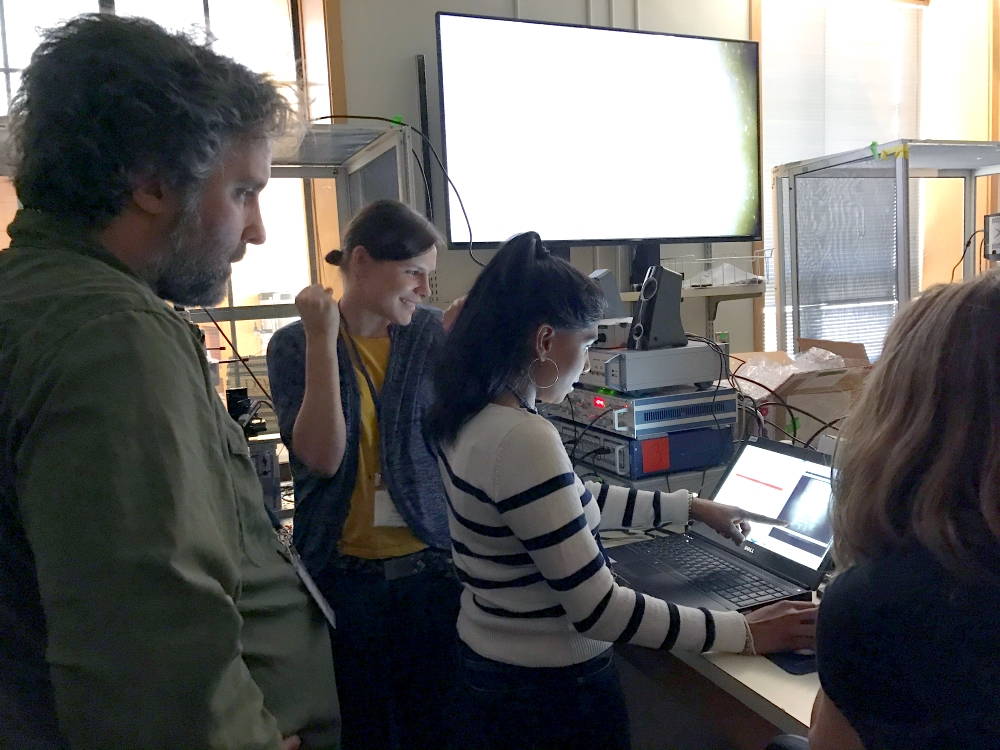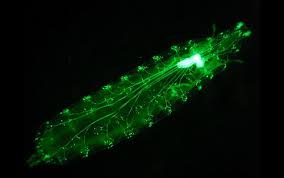We know about the bugs that light up our world: fireflies obviously, glow worms, of course... but fruit fly larvae? It's true. There's a larva lamp wriggling its way into your fruit.
And students at the ‘Drosophila Neurobiology: Genes, Circuits & Behavior’ course at the prestigious Cold Spring Harbor Laboratory in New York State are shining a light on these larvae - literally - as they explore new tools and techniques for using Drosophila as an experimental system for nervous system investigation.
Fruit flies – Drosophila - are important as models for scientists because many of their genes are conserved in humans. Of the genes that mutate to cause diseases in humans, around 75% have similar equivalents in fruit flies.
But Drosophila larvae are also interesting to researchers because ways to remotely control and measure neural activity with light can be installed in parts of their nervous system. Researchers can then engineer these neurons to express a modified version of green fluorescent protein which is sensitive to intracellular calcium. When calcium levels inside the neuron go up, the protein fluoresces more brightly. Since calcium levels typically go up when neurons become active, such genetically encoded calcium indicators can be used to optically image activity in populations of neurons.
Course instructor, Stefan Pulver, a lecturer in neuroscience at St. Andrews University in the UK, utilizes this technology to study the neural control of locomotion in Drosophila. At St Andrews, with support from the McCall MacBain Foundation, Stefan has also been working to adapt this research technology for use in classroom settings.
“One of the advantages of our system is that we can easily image activity patterns in rhythmically active circuits controlling locomotion in both the research lab and the teaching lab. This is the thing we do at Cold Spring Harbor - we do live imaging of neural activity in central pattern generating networks, using LabChart’s Video Capture Module.”
With Stefan’s guidance, students on the Drosophila Neurobiology course use flies in which neurons have been engineered to light up when they are active, using light to image the activity of thousands of neurons in a Drosophila larva at once.

Stefan Pulver and students using LabChart's Video Capture Module to image neural activity in a Drosophila larva
Stefan says that the Drosophila Neurobiology course is unique in that it closely interweaves Drosophila research and teaching.
“It really is the best course to learn about Drosophila neurobiology in a short amount of time - it's like a boot camp. And what’s really cool is that while there's the teaching element to it, we also bring in the best Drosophila researchers in the world to come and talk about their research. The mixture of teaching and research is really interesting and synergistic. Students learn about new types of research and try out experiments – some of which might never have been done before. So, it's not like a traditional classroom – it’s like a functioning research lab.”
The cutting-edge course exposes students to a wide variety of topics and techniques, including the latest approaches for studying nervous system development, activity and connectivity, as well as complex behaviors and disease models.
A huge practical benefit of the course is that students have the chance to try out a variety of equipment from a range of providers. It’s a useful – and rare – opportunity to see which systems might be the best fit for their specific Drosophila research.
ADInstruments are proud to be one of the companies who support the course, providing six PowerLabs for data acquisition during the lab sessions. Stefan Pulver uses LabChart and Video Capture to demonstrate an optogenetic methodology.
The hands-on portion of the course is centered on inquiry-based projects, utilizing the different morphological and physiological measurements and behavioral paradigms learned at the course. This includes molecular-genetic analyses, immunocytochemistry, recording of activity using electrophysiology and genetically encoded calcium indicators, optogenetic and thermogenetic control of neural activity, as well as numerous quantitative behavioral measures. Collectively, the course provides a comprehensive and practical introduction to modern experimental methods for studying the neural basis of behavior in Drosophila.
Attendees at the course benefit from 4 instructors and over 20 international speakers who contribute their knowledge and expertise over its 3-week duration.
We look forward to hearing more about the students' future research using Drosophila larvae!
Find out more about the ‘Drosophila Neurobiology: Genes, Circuits & Behavior’ course here and more about ADInstruments for Researchers here.
About Cold Spring Harbor Lab
Founded in 1890, Cold Spring Harbor Laboratory is a leading international center for research and education. Every year, as part of its mission, the Laboratory organizes 25 scientific conferences, 20 Banbury Center meetings, and 30 advanced technical science courses, with organizers, instructors, and participants from all over the world.

